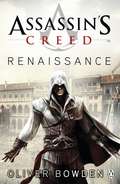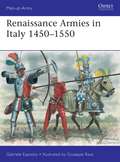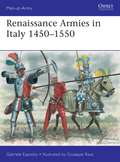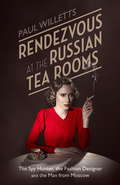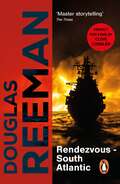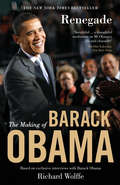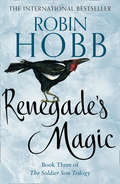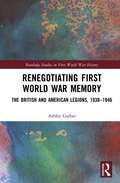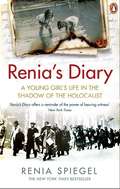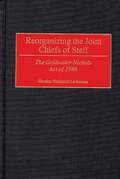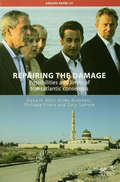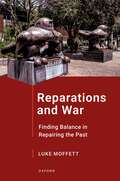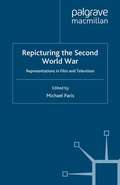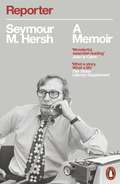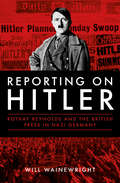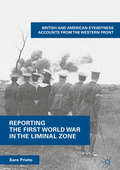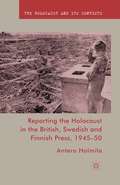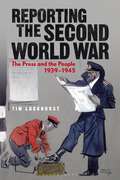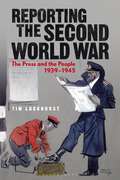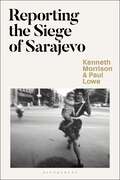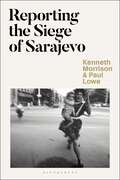- Table View
- List View
Renaissance: Assassin's Creed Book 1 (Assassin's Creed #1)
by Oliver BowdenAssassin's Creed: Renaissance is the thrilling novelisation by Oliver Bowden based on the game series.'I will seek Vengeance upon those who betrayed my family. I am Ezio Auditore di Firenze. I am an Assassin...'The Year of Our Lord 1476 - the Renaissance: culture and art flourish alongside the bloodiest corruption and violence. Bitter blood-feuds rage between the warring political families of Italy.Following the murder of his father and brothers, Ezio Auditore di Firenze is entrusted with an ancient Codex, the key to a conspiracy that goes back to the centuries-old conflict between the shadowy Templar Knights and the elite Order of Assassins.Ezio must avenge the deaths of his kinsmen and in doing so fulfil his destiny, and live by the laws of the Assassin's Creed.Truth is written in bloodAssassin's Creed: Renaissance is based on the phenomenally successful gaming series. Fans of the game will love these stories. Other titles in the series include Assassin's Creed: Forsaken, Assassin's Creed: Brotherhood, Assassin's Creed: The Secret Crusade, and Assassin's Creed: Revelations.Oliver Bowden is the pen-name of an acclaimed novelist.
Renaissance Armies in Italy 1450–1550 (Men-at-Arms)
by Gabriele EspositoThe Italian Renaissance marked a period of political and military turmoil. Many regional wars were fought between the states ruled by Milan, Venice, Genoa, Florence, the Papacy, Siena and Naples. For more than 50 years starting in 1494, major foreign powers also exploited these divisions to invade Italy; both France and Spain made temporary alliances with city states to further their ambitions, and early in the 16th century the Emperor Charles V sent armies from his German realms to support the Spanish.These wars coincided with the growth of disciplined infantry – carrying not only polearms and crossbows but also handguns – which proved capable of challenging the previously dominant armoured knights. The widespread use of mercenaries ushered in the early development of the 'pike and shot' era that succeeded the 'High Middle Ages'. During this period costumes, armour and weapons varied greatly due to their national origins and to the evolution of tactics and technology.This masterfully illustrated study offers a fascinating insight into the many armies which fought in Italy during this turbulent period, explaining not only their arms and equipment, but also their structure and successes and failures on the battlefield.
Renaissance Armies in Italy 1450–1550 (Men-at-Arms #536)
by Gabriele EspositoThe Italian Renaissance marked a period of political and military turmoil. Many regional wars were fought between the states ruled by Milan, Venice, Genoa, Florence, the Papacy, Siena and Naples. For more than 50 years starting in 1494, major foreign powers also exploited these divisions to invade Italy; both France and Spain made temporary alliances with city states to further their ambitions, and early in the 16th century the Emperor Charles V sent armies from his German realms to support the Spanish.These wars coincided with the growth of disciplined infantry – carrying not only polearms and crossbows but also handguns – which proved capable of challenging the previously dominant armoured knights. The widespread use of mercenaries ushered in the early development of the 'pike and shot' era that succeeded the 'High Middle Ages'. During this period costumes, armour and weapons varied greatly due to their national origins and to the evolution of tactics and technology.This masterfully illustrated study offers a fascinating insight into the many armies which fought in Italy during this turbulent period, explaining not only their arms and equipment, but also their structure and successes and failures on the battlefield.
Rendezvous at the Russian Tea Rooms: The Spyhunter, the Fashion Designer & the Man From Moscow
by Paul WillettsRendezvous at the Russian Tea Rooms provides the first comprehensive account of what was once hailed by a leading American newspaper as the greatest spy story of World War II. This dramatic yet little-known saga, replete with telephone taps, kidnappings, and police surveillance, centres on the furtive escapades of Tyler Kent, a handsome, womanising 28-year-old Ivy League graduate, who doubles as a US Embassy code clerk and Soviet agent. Against the backdrop of London high society during the so-called Phoney War, Kent's life intersects with the lives of the book's two other memorably flamboyant protagonists. One of those is Maxwell Knight, an urbane, endearingly eccentric MI5 spyhunter. The other is Anna Wolkoff, a White Russian fashion designer and Nazi spy whose outfits are worn by the Duchess of Windsor and whose parents are friends of the British royal family. Wolkoff belongs to a fascist secret society called the Right Club, which aims to overthrow the British government. Her romantic entanglement with Tyler Kent gives her access to a secret correspondence between President Roosevelt and Winston Churchill, a correspondence that has the potential to transform the outcome of the war.
Rendezvous - South Atlantic: A ship past its prime, with one last fateful mission…
by Douglas ReemanIn 1941, when she was turned into an armed merchant cruiser, the S.S. Benbecula was already old. Yet even she was needed to protect the vital Atlantic sea lanes.Commander Lindsay, her new captain, had to work desperately to mould the ship's company - raw recruits and old timers - into a fighting force.And better than anyone, Lindsay knew this could be his last command, his last chance...
Renegade: The Making of Barack Obama
by Richard WolffeDuring his presidential campaign, Barack Obama himself told veteran political reporter Richard Wolffe, 'You'll get more access than anyone else', and Renegade is his unique story of how a political newcomer with no money and an outsider's name grew into the world's most powerful leader. But it is also a uniquely intimate portrait of the person behind the iconic posters and the man codenamed 'Renegade' by his Secret Service protectors. Wolffe portrays an historic candidate and his - until now - inscrutable character and campaign in untold, stunning detail, from his university lecturer's office in Iowa to the Oval Office in Washington. With unprecedented access, gained over a dozen exclusive interviews with Obama, Wolffe shares with us his front row seat. We fly on the candidate's plane and ride in his bus on an odyssey across a country in crisis; we stand next to him at a bar on the night he secures the nomination; and feel the tension backstage as he delivers his convention speech to a stadium crowd and a transfixed TV audience.Renegade is not just an election epic but is also an insightful biography of the new President of the United States.
Renegade’s Magic (The Soldier Son Trilogy #3)
by Robin Hobb‘Fantasy as it ought to be written’ George R.R. Martin
Renegotiating First World War Memory: The British and American Legions, 1938–1946 (Routledge Studies in First World War History)
by Ashley GarberFirst World War-based ex-servicemen’s organisations found themselves facing an existential crisis with the onset of the Second World War. This book examines how two such groups, the British and American Legions, adapted cognitively to the emergence of yet another world war and its veterans in the years 1938 through 1946. With collective identities and socio-political programmes based in First World War memory, both Legions renegotiated existing narratives of that war and the lessons they derived from those narratives as they responded to the unfolding Second World War in real time. Using the previous war as a "learning experience" for the new one privileged certain understandings of that conflict over others, inflecting its meaning for each Legion moving forward. Breaking the Second World War down into its constituent events to trace the evolution of First World War memory through everyday invocations, this unprecedented comparison of the British and American Legions illuminates the ways in which differing international, national, and organisational contexts intersected to shape this process as well as the common factors affecting it in both groups. The book will appeal most to researchers of the ex-service movement, First World War memory, and the cultural history of the Second World War.
Renegotiating First World War Memory: The British and American Legions, 1938–1946 (Routledge Studies in First World War History)
by Ashley GarberFirst World War-based ex-servicemen’s organisations found themselves facing an existential crisis with the onset of the Second World War. This book examines how two such groups, the British and American Legions, adapted cognitively to the emergence of yet another world war and its veterans in the years 1938 through 1946. With collective identities and socio-political programmes based in First World War memory, both Legions renegotiated existing narratives of that war and the lessons they derived from those narratives as they responded to the unfolding Second World War in real time. Using the previous war as a "learning experience" for the new one privileged certain understandings of that conflict over others, inflecting its meaning for each Legion moving forward. Breaking the Second World War down into its constituent events to trace the evolution of First World War memory through everyday invocations, this unprecedented comparison of the British and American Legions illuminates the ways in which differing international, national, and organisational contexts intersected to shape this process as well as the common factors affecting it in both groups. The book will appeal most to researchers of the ex-service movement, First World War memory, and the cultural history of the Second World War.
Renia’s Diary: A Young Girl’s Life in the Shadow of the Holocaust
by Renia SpiegelIntroduction by Deborah E. Lipstadt, author of DenialJuly 15, 1942, WednesdayRemember this day; remember it well. You will tell generations to come. Since 8 o’clock today we have been shut away in the ghetto. I live here now. The world is separated from me and I’m separated from the world.Renia is a young girl who dreams of becoming a poet. But Renia is Jewish, she lives in Poland and the year is 1939. When Russia and Germany invade her country, Renia's world shatters. Separated from her mother, her life takes on a new urgency as she flees Przemysl to escape night bombing raids, observes the disappearances of other Jewish families and, finally, witnesses the creation of the ghetto.But alongside the terror of war, there is also great beauty, as she begins to find her voice as a writer and falls in love for the first time. She and the boy she falls in love with, Zygmunt, share their first kiss a few hours before the Nazis reach her hometown. And it is Zygmunt who writes the final, heartbreaking entry in Renia’s diary.Recently rediscovered after seventy years, Renia’s Diary is already being described as a classic of Holocaust literature. Written with a clarity and skill that is reminiscent of Anne Frank, Renia's Diary also includes a prologue and epilogue by Renia's sister Elizabeth, as well as an introduction by Deborah E. Lipstadt, author of Denial. It is an extraordinary testament to both the horrors of war, and to the life that can exist even in the darkest times.
Reorganizing the Joint Chiefs of Staff: The Goldwater-Nichols Act of 1986 (Contributions in Military Studies)
by Gordon LedermanThe Goldwater-Nichols Department of Defense Reorganization Act of 1986 is the most important legislation to affecting U.S. national defense in the last 50 years. This act resulted from frustration in Congress and among certain military officers concerning what they believed to be the poor quality of military advice available to civilian decision-makers. It also derived from the U.S. military's perceived inability to conduct successful joint or multi-service operations. The act, passes after four years of legislative debate, designated the Chairman of the Joint Chiefs of Staff as the principal military advisor to the President and sought to foster greater cooperation among the military services. Goldwater-Nichols marks the latest attempt to balance competing tendencies within the Department of Defense, namely centralization versus decentralization and geographic versus functional distributions of power.As a result of the Goldwater-Nichols Act, the Chairman of the Joint Chiefs has achieved prominence, but his assignment is somewhat contradictory: the spokesman and thus the advocate for the Commander in Chief, while simultaneously the provider of objective advice to the President. While the act did succeed in strengthening the CINCs' authority and in contributing to the dramatic U.S. achievements in the Gulf War, the air and ground campaigns revealed weaknesses in the CINCs' capability to plan joint operations. In addition, the increased role of the military in ad hoc peacekeeping operations has challenged the U.S. military's current organizational structure for the quick deployment of troops from the various services. Rapid technological advances and post-Cold War strategic uncertainty also complicate the U.S. military's organizational structure.
Repairing the Damage: Possibilities and Limits of Transatlantic Consensus (Adelphi series)
by Dana H. Allin Gilles Andréani Gary Samore Philippe ErreraThe damage that has been done to the transatlantic alliance will not be repaired through grand architectural redesigns or radical new agendas. Instead, the transatlantic partners need to restore their consensus and cooperation on key security challenges with a limited agenda that reflects the essential conservatism of the transatlantic partnership during the Cold War and the 1990s. There will inevitably be big challenges, such as the rise of China, where transatlantic disparities in strategic means and commitments preclude any common alliance undertaking. Yet such limits are nothing new. The absence of a common transatlantic commitment to counter-insurgency in Iraq may cause resentments, but so too did the lack of a common commitment to counter-insurgency in Vietnam. This Adelphi Paper suggests ten propositions for future transatlantic consensus – that is to say, ten security challenges for which the allies should be able to agree on common strategies. These run the gamut from an effective strategy to prevent Iran from developing a nuclear weapons capability to transatlantic leadership for international cooperation against global warming. If pursued with seriousness and a reasonable degree of transatlantic unity, these propositions could constitute the foundations of an effective partnership. They are, in the authors’ view, the basis for a consensus on the most pressing security challenges of the twenty-first century. The time is right for this kind of serious rededication to alliance purposes. There has already been some effort to repair the damage; moreover, new leaders are in place or coming to the countries that were major protagonists of the transatlantic crisis: Germany, France, Britain and, in 2009, the United States. It is possible that these four new leaders will be better able to put the disputes of the recent past behind them. This extended essay is a guide to the possibilities, and also the limits, of a new start.
Repairing the Damage: Possibilities and Limits of Transatlantic Consensus (Adelphi series)
by Dana H. Allin Gilles Andréani Gary Samore Philippe ErreraThe damage that has been done to the transatlantic alliance will not be repaired through grand architectural redesigns or radical new agendas. Instead, the transatlantic partners need to restore their consensus and cooperation on key security challenges with a limited agenda that reflects the essential conservatism of the transatlantic partnership during the Cold War and the 1990s. There will inevitably be big challenges, such as the rise of China, where transatlantic disparities in strategic means and commitments preclude any common alliance undertaking. Yet such limits are nothing new. The absence of a common transatlantic commitment to counter-insurgency in Iraq may cause resentments, but so too did the lack of a common commitment to counter-insurgency in Vietnam. This Adelphi Paper suggests ten propositions for future transatlantic consensus – that is to say, ten security challenges for which the allies should be able to agree on common strategies. These run the gamut from an effective strategy to prevent Iran from developing a nuclear weapons capability to transatlantic leadership for international cooperation against global warming. If pursued with seriousness and a reasonable degree of transatlantic unity, these propositions could constitute the foundations of an effective partnership. They are, in the authors’ view, the basis for a consensus on the most pressing security challenges of the twenty-first century. The time is right for this kind of serious rededication to alliance purposes. There has already been some effort to repair the damage; moreover, new leaders are in place or coming to the countries that were major protagonists of the transatlantic crisis: Germany, France, Britain and, in 2009, the United States. It is possible that these four new leaders will be better able to put the disputes of the recent past behind them. This extended essay is a guide to the possibilities, and also the limits, of a new start.
Reparations and War: Finding Balance in Repairing the Past
by Luke MoffettWar devastates the lives of those who are caught up in it. For thousands of years, reparations have been used to secure the end of war and alleviate its deleterious consequences. More recently, human rights law has established that victims have a right to reparations. Yet, in the face of conflicts that last for decades with millions of victims, how feasible are reparations? And what are the obstacles to delivering them? Using interviews with hundreds of victims, ex-combatants, government officials, and civil society actors from six post-conflict countries, Reparations and War examines the history, theoretical justifications, and practical challenges of implementing reparations after war. It examines the role of non-state armed groups in making reparations, the role of victim mobilisation, the evolving use of reparations, and the political instrumentalization of redress. Luke Moffett offers a measured and honest account of what reparations can and cannot do. This book sheds new light on how reparations can be politically manipulated, or used to reward those loyal to the State, rather than to achieve justice for the victims who suffer.
Reparations and War: Finding Balance in Repairing the Past
by Luke MoffettWar devastates the lives of those who are caught up in it. For thousands of years, reparations have been used to secure the end of war and alleviate its deleterious consequences. More recently, human rights law has established that victims have a right to reparations. Yet, in the face of conflicts that last for decades with millions of victims, how feasible are reparations? And what are the obstacles to delivering them? Using interviews with hundreds of victims, ex-combatants, government officials, and civil society actors from six post-conflict countries, Reparations and War examines the history, theoretical justifications, and practical challenges of implementing reparations after war. It examines the role of non-state armed groups in making reparations, the role of victim mobilisation, the evolving use of reparations, and the political instrumentalization of redress. Luke Moffett offers a measured and honest account of what reparations can and cannot do. This book sheds new light on how reparations can be politically manipulated, or used to reward those loyal to the State, rather than to achieve justice for the victims who suffer.
Repicturing the Second World War: Representations in Film and Television
by Michael ParisFilms and television dramas about the Second World War have always been popular. Written by acknowledged experts in the field, this collection offers challenging, sometimes controversial, insights into how the popular memory of the Second World War has been 're-pictured' since 1989, which marked the sixtieth anniversary of the start of the war.
Reporter: A Memoir
by Seymour M. Hersh'Reporter is just wonderful. Truly a great life, and what shines out of the book, amid the low cunning and tireless legwork, is Hersh's warmth and humanity. Essential reading for every journalist and aspiring journalist the world over' John le CarréIn the early 1950s, teenage Seymour Hersh was finishing high school and university - while running the family's struggling dry cleaning store in a Southside Chicago ghetto. Today, he is one of America's premier investigative journalists, whose fearless reporting has earned him fame, front-page bylines in virtually every newspaper in the world, a staggering collection of awards, and no small amount of controversy.Reporter is the story of how he did it. It is a story of slog, ingenuity and defiance, following Hersh from his first job as a crime reporter for the Chicago City News Bureau, through his Pulitzer Prize-winning freelance investigative exposes, to the heights of his reporting for The New York Times and the New Yorker. It is a tale of night-time encounters with great Civil Rights leaders, unauthorised meetings with Pentagon officials, raucous dinners with Canadian soldiers in Hanoi, tense phone calls with Secretaries of State, desperate to save face; of exposing myriad military and political wrongdoing, from My Lai to Watergate to Abu Ghraib, and the cynical cover-ups that followed in Washington and New York. Here too are unforgettable encounters with some of the most formidable figures from recent decades, from Saul Bellow to Martin Luther King Jr., from Henry Kissinger to Bashar al-Assad.Ultimately, in unfurling Seymour Hersh's life and career, Reporter tells a story of twentieth-century America, in all its excitement and darkness.
Reporting on Hitler: Rothay Reynolds and the British Press in Nazi Germany
by Will WainewrightAllegedly the only man capable of holding the Führer's intense gaze, Rothay Reynolds was a leading foreign correspondent between the wars and ran the Daily Mail's bureau in Berlin throughout the 1920s and 1930s. The enigmatic former clergyman was one of the first journalists to interview Adolf Hitler, meeting the future Führer days before the Munich Putsch.While the awful realities of the Third Reich were becoming apparent on the ground in Germany, in Britain the Daily Mail continued to support the Nazi regime. Reynolds's time as a foreign correspondent in Nazi Germany provides some startling insights into the muzzling of the international press prior to the Second World War, as journalists walked uneasy tightropes between their employers' politics and their own journalistic integrity. As war approached, the stakes - and the threats from the Gestapo - rose dramatically.Reporting on Hitler reveals the gripping story of Rothay Reynolds and the intrepid foreign correspondents who reported on some of the twentieth century's most momentous events in the face of sinister propaganda, brazen censorship and the threat of expulsion - or worse - if they didn't toe the Nazis' line. It uncovers the bravery of the forgotten heroes from a golden age of British journalism, who risked everything to tell the world the truth.
Reporting the First World War in the Liminal Zone: British and American Eyewitness Accounts from the Western Front
by Sara PrietoThis book deals with an aspect of the Great War that has been largely overlooked: the war reportage written based on British and American authors’ experiences at the Western Front. It focuses on how the liminal experience of the First World War was portrayed in a series of works of literary journalism at different stages of the conflict, from the summer of 1914 to the Armistice in November 1918.Sara Prieto explores a number of representative texts written by a series of civilian eyewitness who have been passed over in earlier studies of literature and journalism in the Great War. The texts under discussion are situated in the ‘liminal zone’, as they were written in the middle of a transitional period, half-way between two radically different literary styles: the romantic and idealising ante bellum tradition, and the cynical and disillusioned modernist school of writing. They are also the product of the various stages of a physical and moral journey which took several authors into the fantastic albeit nightmarish world of the Western Front, where their understanding of reality was transformed beyond anything they could have anticipated.
Reporting the First World War in the Liminal Zone (PDF): British and American Eyewitness Accounts from the Western Front
by Sara PrietoThis book deals with an aspect of the Great War that has been largely overlooked: the war reportage written based on British and American authors’ experiences at the Western Front. It focuses on how the liminal experience of the First World War was portrayed in a series of works of literary journalism at different stages of the conflict, from the summer of 1914 to the Armistice in November 1918.Sara Prieto explores a number of representative texts written by a series of civilian eyewitness who have been passed over in earlier studies of literature and journalism in the Great War. The texts under discussion are situated in the ‘liminal zone’, as they were written in the middle of a transitional period, half-way between two radically different literary styles: the romantic and idealising ante bellum tradition, and the cynical and disillusioned modernist school of writing. They are also the product of the various stages of a physical and moral journey which took several authors into the fantastic albeit nightmarish world of the Western Front, where their understanding of reality was transformed beyond anything they could have anticipated.
Reporting the Holocaust in the British, Swedish and Finnish Press, 1945-50 (The Holocaust and its Contexts)
by A. HolmilaExamining how the press in Britain, Sweden and Finland responded to the Holocaust immediately after the Second World War, Holmila offers new insights into the challenge posed by the Holocaust for liberal democracies by looking at the reporting of the liberation of the camps, the Nuremberg trial and the Jewish immigration to Palestine.
Reporting the Second World War: The Press and the People 1939-1945
by Tim LuckhurstThe decisive role of Britain's wartime newspaper journalism in shaping public opinion and government policy has been majorly overlooked. Much of the existing historiography has framed Britain's newspapers as mouthpieces of state propaganda, readily conforming to the wishes of the wartime coalition. Tim Luckhurst challenges this through an analysis of illuminating and largely forgotten controversies which underscore the function the press held as guardians of democracy and propagators of dissenting opinion in British politics and society - from the overseas evacuation of children to the Allies' carpet bombing of German cities.Reporting the Second World War is a timely and important intervention that duly recognises the place of national, regional and specialist titles in speaking truth to power in a democracy at war.
Reporting the Second World War: The Press and the People 1939-1945
by Tim LuckhurstThe decisive role of Britain's wartime newspaper journalism in shaping public opinion and government policy has been majorly overlooked. Much of the existing historiography has framed Britain's newspapers as mouthpieces of state propaganda, readily conforming to the wishes of the wartime coalition. Tim Luckhurst challenges this through an analysis of illuminating and largely forgotten controversies which underscore the function the press held as guardians of democracy and propagators of dissenting opinion in British politics and society - from the overseas evacuation of children to the Allies' carpet bombing of German cities.Reporting the Second World War is a timely and important intervention that duly recognises the place of national, regional and specialist titles in speaking truth to power in a democracy at war.
Reporting the Siege of Sarajevo
by Kenneth Morrison Paul LoweThe Siege of Sarajevo remains the longest siege in modern European history, lasting three times longer than the Battle of Stalingrad and over a year longer than the Siege of Leningrad. Reporting the Siege of Sarajevo provides the first detailed account of the reporting of this siege and the role that journalists played in highlighting both military and non-military aspects of it. The book draws on detailed primary and secondary material in English and Bosnian, as well as extensive interviews with international correspondents who covered events in Sarajevo from within siege lines. It also includes hitherto unpublished images taken by the co-author and award-winning photojournalist, Paul Lowe.Together Morrison and Lowe document a relatively short but crucial period in both the history of Bosnia & Herzegovina, the city of Sarajevo and the profession of journalism. The book provides crucial observations and insights into an under-researched aspect of a critical period in Europe's recent history.
Reporting the Siege of Sarajevo
by Kenneth Morrison Paul LoweThe Siege of Sarajevo remains the longest siege in modern European history, lasting three times longer than the Battle of Stalingrad and over a year longer than the Siege of Leningrad. Reporting the Siege of Sarajevo provides the first detailed account of the reporting of this siege and the role that journalists played in highlighting both military and non-military aspects of it. The book draws on detailed primary and secondary material in English and Bosnian, as well as extensive interviews with international correspondents who covered events in Sarajevo from within siege lines. It also includes hitherto unpublished images taken by the co-author and award-winning photojournalist, Paul Lowe.Together Morrison and Lowe document a relatively short but crucial period in both the history of Bosnia & Herzegovina, the city of Sarajevo and the profession of journalism. The book provides crucial observations and insights into an under-researched aspect of a critical period in Europe's recent history.
